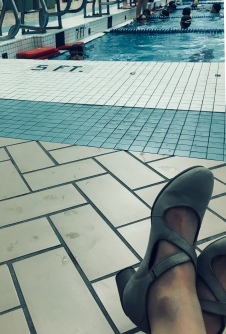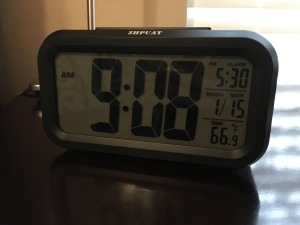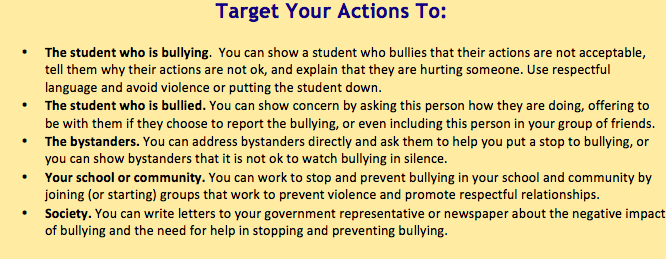 Throwback to yesterday- I prepped some slides for a big talk later this week, finished a few time sensitive tasks related to patient care, made it through a couple of high level meetings, and then rushed off to relieve a sick babysitter. That’s how I ended up sitting poolside in a blazer and heels, with the amazing bonus of getting to watch this guy swim some laps (which rarely happens).
Throwback to yesterday- I prepped some slides for a big talk later this week, finished a few time sensitive tasks related to patient care, made it through a couple of high level meetings, and then rushed off to relieve a sick babysitter. That’s how I ended up sitting poolside in a blazer and heels, with the amazing bonus of getting to watch this guy swim some laps (which rarely happens).
There’s a conversation happening over at #doctorsofinstagram about having it all and whether that’s even possible. Here’s my take, formed by more than 10 years in full-time practice and 8 precious years as a mom, but still a serious work in progress:
First, each of us can only define what it means to have it all for ourselves. Working full time and not having kids might be having it all for one person, staying at home with kids and not working might be having it all for another. And everything in between. It’s all okay. We define happiness and life goals for ourselves.
Second, I think you can have it all (defined for me personally as having both a successful career and a fulfilling life with family outside work), but I don’t think you can have it all in every part of your life all at the same time. What I mean is this- if you see me being successful at work, I am probably missing something at home. If I’m having a great day as a mom, which I loosely define as spending quality time with my son, I probably have open clinic charts that are waiting for my attention. There are hours, days, months, years, when I need to lean in at home and others that I lean in to work. And, that’s okay. Shonda Rhimes writes eloquently about this in her great book, “The Year of Yes”.
Third, I’m at the point where instead of aiming to have it all, most days my goal is to simply have it together. For me, the term “having it all” suggests we should try to “be it all” and do it all perfectly. This sets working parents in particular up for an unattainable goal and feelings of overwhelm. Instead, increasingly my aim is to try to do my best with everything on my plate, and make peace with all of the times that things don’t go exactly as planned (which occurs pretty much daily). And it’s only over the last couple of years that I’ve gotten back to any semblance of a fitness routine and some time for self-care without feeling guilty. This is after repeated readings of “The Gifts of Imperfection” by Brene Brown (if you think at all about these kinds of things, please go read ALL of her books right now :))
Finally, I’ll say this- anyone who looks like they have it all probably has a lot of help. I only survive (and sometimes thrive) because I have an amazing team of people both at work and at home who I partner with to keep it all running and I’m extremely privileged to have them in my life.
What does having it all or living your best life mean to you?
Page Turners for Grade Schoolers

My 7-year-old is now at the point where he can easily tackle chapter books on his own, but we still end each day spending some time reading together at bedtime. It is a treasured moment- very often the best part of my day.
We are now at the point where he’s well beyond most picture books- although I will never be 😉 -and not yet ready for most YA material. The elementary years are a time when reading ability sometimes outpaces readiness for the mature themes found in some chapter books. I had started to feel that we had a dearth of good options, until I asked my friends (a group that luckily includes elementary teachers, librarians, and any number of voracious readers). They quickly reminded me of some wonderful authors and books from my own childhood that I had not yet shared with my son, and also introduced a number of great new options.
I’ve had a number of requests to share this list, which is by no means exhaustive. Please feel free to add your favorites!
Authors:
A number of authors were mentioned over and over again as tops for elementary readers, including: Beverly Cleary, Roald Dahl, E.B. White, Madeleine L’Engle, and Judy Blume.
Series:
Recommended series included “How to Train Your Dragon”, The “Magic Tree House” books, “The Spiderwick Chronicles”, “Wayside School”, “Secret Agent Jack Stalwart”, “Ricky Ricotta”, and of course, “Harry Potter”. Classics like The Little House series and The Boxcar Children were also mentioned.
Resources:
A couple of wonderful resources were suggested including: Read Aloud Revival , Book Crush by Nancy Pearl, a list of read aloud books from Common Sense Media, and Jim Trelease’s Read–Aloud Handbook. Finally, Goodreads is my favorite place to curate books I’ve read or want to read. I’ve collected all of the recommendations I’ve received for elementary chapter books here, and there are any number of other compiled lists on Goodreads.
Happy reading and thanks to all whose recommendations got us back on track after a few duds (that shall remain nameless).
Excuses

Until very recently I was among the nearly three-quarters of American smartphone owners who sleep with their phone next to their bed. I routinely spent a fair amount of time scrolling just prior to sleep. This, despite recommending to parents at least weekly in clinic that they get their child’s gadgets out of their bedroom if they wanted to increase sleep quality and quantity.
For about a year now (okay, let’s be honest, at least two) I’ve been telling myself I needed to make a change. I wanted more peaceful thoughts running through my head when I closed my eyes each night; instead of the myriad news stories that Facebook put in front of me, or the work email that I just couldn’t shake. I wanted to control my phone instead of it controlling me. I had done pretty well with this in other ways- taking periodic digital sabbaths and gradually decreasing my overall screen time by tracking it.
But taking this final step was elusive. I had an excuse. A rationalization. A road block. The thought that runs through your head when you know you need to make a change, but cannot do it, and so convince yourself that it makes sense to maintain the status quo. In this case? I didn’t have an alarm clock. I really needed my phone to be my alarm clock.
Then my son got a tablet for Christmas. I had pretty mixed feelings about this but it is a fairly simple model that he uses for homework (and of course his “videos”). We set up some screen time rules around its use and one of those rules is that the tablet has a bedtime. It charges in a docking station in the family room. Here I was, telling my son that his tablet had a bedtime but I couldn’t give my phone the same.
So I bought an alarm clock. Ten dollars later and I am free. It’s been almost two months since my phone joined the tablet at its docking station each evening and, wow, I’m never going back. Better sleep. Peace of mind. More reading. Less parental guilt. And no more excuses.
The Upstander: How They Stand Up to Bullying
The following post was written by guest author, Dr. Shelagh Dunn.
Although I didn’t know it at the time, I’m pretty sure I chose the research topic of my doctoral dissertation for personal reasons. I studied upstanders to bullying by interviewing middle school students who stood up to bullying in their schools. I thought I might someday be helping teachers and schools to lessen bullying. But it turns out that the students I was studying were my teachers. I learned so much about how to be an effective citizen and a decent human being from these student upstanders. You see, I used to see violence in the news and feel horror and pain but not know what to do about it. These students knew these feelings too but they also possessed a wisdom and resolve that I’m still only learning about. I’d like to share some of what I’ve learned with you. We need their knowledge now more than ever.
Why am I talking about bullying right now? Well, it’s common to think of bullying in schools as “kids being kids” or to say “kids can be so cruel” and dismiss the cruelty of bullying as something that children grow out of. I don’t see it this way at all. What I’ve come to learn is that bullying is a microcosm of our society. Children are using their eyes and ears to absorb the world around them and they act it out with one another at school. It is not surprising to hear that right now there are increasing reports of bullying in schools targeting race, faith, and gender, when these very things are being targeted by politicians in the media.
But here’s the thing, stopping bullying is hard, in part because being an upstander is hard. As adults, we do not have this figured out. Most of us don’t know what to do when we witness violence, discrimination or hate, and even if we know what to do, we sometimes don’t do it. In the 1950’s a psychologist named Asch found that when a person is shown lines of obviously different lengths and asked to tell which line is the shortest, they can easily do so… unless they are in a room of people purposefully giving the wrong answer. In these cases, most people will give in and give the same answer as the group even when they know it is wrong. It’s just too hard to be the only one in a group saying something different. There is also another phenomenon acting against us called the “bystander effect” which shows that people will not come to the aid of someone in need as often if there are others around, because we believe that someone else will help. All of this means that there are incredible social forces acting on us to prevent us from intervening when we witness something like bullying, discrimination, or hate-fuelled behavior. We don’t want to be different, we think someone else will do it. Add in the threat of social and physical harm that can come with taking this stuff on and it becomes a very special and unique quality to be an upstander.
So how are some people able to be upstanders? Here’s what the students I interviewed had to say. They all told me that they had been bullied themselves at least once before and had a strong sense of empathy for others being bullied. They all told me that they knew bullying was wrong and they had to do something about it. They all told me that they didn’t care so much about what other students thought of them, they were not afraid to be different. Most of them used specific tactics to intervene using the means that they had available. Most of them took on what I realized was the identity of an upstander – it wasn’t just something they did, it was something they were. It became a part of their moral character to do the right thing even when it’s hard.
We can learn to adopt these qualities and teach them to our kids. Empathy. Resolve. Being unafraid to be different. There are strategies and places to start. As we practice using our empathy, using our voice, and listening to our own sense of right and wrong, even when everyone else around us is silent, here are a very specific set of instructions from these students to their peers and teachers, reprinted here for you to think about.

If you think these instructions might help a school deal with bullying, please try them out. But here is my real challenge to you. If bullying is the microcosm, then we adults live in the macrocosm. Look at the list of actions above. Pick one. Do it today. Sleep. Repeat. Your children are watching.
“In the end, we will remember not the words of our enemies but the silence of our friends.” – Dr. Martin Luther King Jr.
Dr. Shelagh Dunn is a Registered Psychologist in Edmonton, Alberta, Canada. She has a private practice in counselling psychology, with an interest in positive psychology and the health benefits of creating social change.
Healthy, Kid-Approved Meals and Snacks
 We do a fairly good job of eating healthy at our house, particularly for dinner, but we have recently been in a rut with healthy options that my 6-year-old will actually eat for breakfast, lunch, and after school snacks. He’s also at the age where he likes to get involved in food choices and (occasionally) food preparation.
We do a fairly good job of eating healthy at our house, particularly for dinner, but we have recently been in a rut with healthy options that my 6-year-old will actually eat for breakfast, lunch, and after school snacks. He’s also at the age where he likes to get involved in food choices and (occasionally) food preparation.
So, to mix things up a bit I crowd-sourced for new ideas this week (and boy did folks come through with some great ideas)! My plan for 2017 is to have this chart up on the fridge and involve my son in meal planning. Each Saturday before grocery shopping he can pick two items from each category and I’ll make sure we have the ingredients on hand for the following week. During my usual Sunday meal prep, I’m going to try to involve him in getting his own BF/lunch/snacks ready for the week.
Additional helpful resources:
This is a living document so if you have more ideas or helpful resources, please share in the comments. The first PDF includes our ideas, the second is left blank for your family’s imagination. I’ll let you know how it goes!
Kid-Approved Breakfast, Lunch, and Snacks PDF: kidapprovedbls
Kid-Approved Breakfast, Lunch, and Snacks (blank) PDF: blankbls
Home
Last July I left the Bay Area after living there for ten years. This summer, I returned to visit for the first time. I found myself awash in thoughts of “home”. Here I was, in a place that never truly felt like what I conceptualized as home while I lived there, and yet I felt nostalgic. The familiar streets. The old haunts. The place where I became a mom and pediatrician. The people. It’s the people. My people. The friends who became family. The people around whom you can be completely yourself without a second thought. Is that what “home” is?
Maybe.
Yet, home is also now Dallas. Of course it is. Home is where my husband and son are. It is where my job is. It is where, after a year, we are starting to build a community and already have dear friends. It’s just not quite as worn-in yet. Not quite as easy and comfortable. It still requires a GPS. But it’s “home”, right?
Maybe.
Because, deep down, in a way I didn’t fully appreciate prior to spending a decade moving around, home is also where I spent my childhood. Wisconsin. Home is where my family is. Where I grew into the person I am. Where I have lifelong friends who just know me. Where the way things are done is expected and familiar. At least that’s how I imagine it. Perhaps it is a nostalgic lens. If I lived there now would it feel the same? After all of this time, would the glove still fit?
Maybe.
And that’s when I start wishing for a teleporter. Because home is, of course, all of these. And while there is a twinge of envy for those who have all of these homes in one place, I wouldn’t change a thing. Each of these “homes” is now weaved together into the fabric of my life.
They say you can’t go home again. But maybe you already are.
Maybe.
One Word for 2015: Gratitude
 At the start of each of the last few years I’ve focused on words instead of specific resolutions and have found it much more meaningful and effective. In 2013 it was Decide, Attend, and Play. Last year I added Focus, Accept, and Sleep. This year I’m going to try something a little different. I’m going to continue to think about the good words I’ve already got and add only one more: Gratitude.
At the start of each of the last few years I’ve focused on words instead of specific resolutions and have found it much more meaningful and effective. In 2013 it was Decide, Attend, and Play. Last year I added Focus, Accept, and Sleep. This year I’m going to try something a little different. I’m going to continue to think about the good words I’ve already got and add only one more: Gratitude.
2014 brought its share of challenges and I frankly wasn’t all that sad to see it go. But, as I reflect on the year that was, I realize that I was also blessed with many great memories shared with wonderful people, and that the “bad” stuff wasn’t really as hard as it might have felt in the moment. I see now that things started to look up when I began to shift my focus and think about all that I was grateful for.
I also know that I want to raise a kind and generous son who is able to cultivate gratitude (more on this in a future post). And, I know that if I want to do this, I must model it myself.
So 2015 will be a year of daily reflection on gratitude in both abstract and more concrete ways:
- Last November we started a bedtime routine of sharing one thing we were grateful for during the day. It has been revealing, wonderful, and at times very humorous (my son has, on more than occasion, mentioned his gratitude for lunch). We’re continuing this practice in 2015 and I’ve started a gratitude journal to keep track.
- This year I’ll be more mindful of the amazing people in my life and more vocal in my appreciation for all they do and are. I’ll share more compliments. I’ll be better about staying in touch. I’ll do all I can to be with loved ones.
- I’ll spend time outdoors each and every day. Wow, writing that down it sounds pretty audacious, but it’s gonna happen. Even if it’s cold (or hot) and even if it’s only 10 minutes. The beauty of the world around us never fails to improve my mood and inspire gratitude for the profound gift of life itself.
I’ll leave you with this lovely 6 minute video which pairs beautiful images with a message of gratitude and mindfulness including, “You think this is just another day in your life. It’s not just another day. It’s the one day that is given to you. Today. It is given to you. It’s a gift.”
The Cure for a Case of the Bah Humbugs

I must admit that I occasionally come down with a case of the “bah humbugs” this time of year. The etiology seems to be multi-factorial. Distance from both sides of our extended family and commercialization of the holiday season both contribute. Reading the news doesn’t help. This year, I’m particularly struck by the fact that for most of the kids I take care of the holiday season is actually a pretty difficult time of year. Whatever the cause, there are times that I just haven’t been feelin’ that holiday spirit.
Luckily, I have found a sure fire cure for this malaise. Continue reading
Vulnerable
It’s when I’m putting my son to bed at night that I feel it most acutely. Smelling his hair. Watching him breathe. It overwhelms me. There’s a name for what I’m feeling. Vulnerable.
Absolute and total vulnerability. Vulnerability that comes from a love so profound it cannot be described. I think, no one told me about this part of parenting. But then I think that even if they had I wouldn’t have understood. Heart on my sleeve isn’t the half of it. Continue reading
Helping Young Kids Adjust to a Move
 It’s funny, growing up I didn’t really move at all. I lived in the same house in a small midwestern town from age 2 to 18. But, since leaving home for college I’ve had my share of moves. Seventeen different abodes in now three states. I didn’t really mean to turn into a nomad, it just sort of happened. You get pretty good at paring down belongings and change of address notifications. Continue reading
It’s funny, growing up I didn’t really move at all. I lived in the same house in a small midwestern town from age 2 to 18. But, since leaving home for college I’ve had my share of moves. Seventeen different abodes in now three states. I didn’t really mean to turn into a nomad, it just sort of happened. You get pretty good at paring down belongings and change of address notifications. Continue reading

